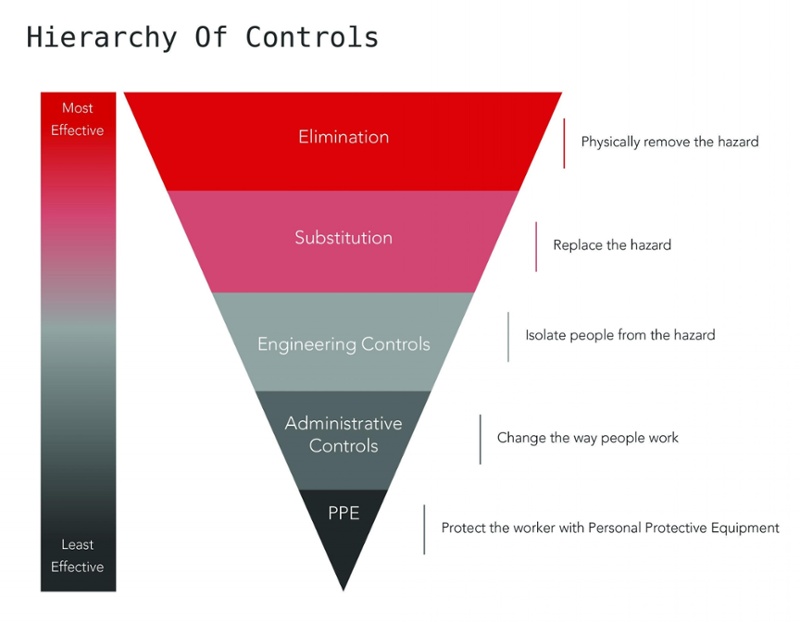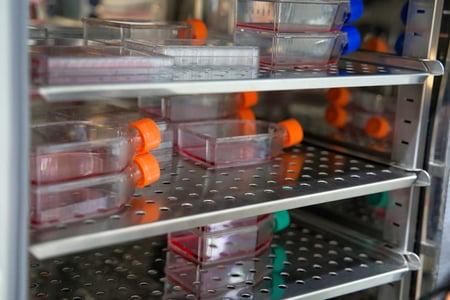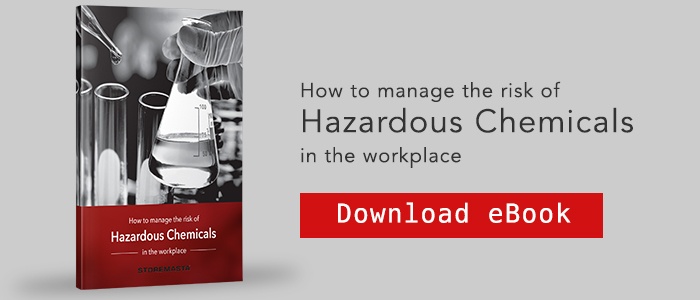Laboratories typically have many different types of chemicals that must be stored. And because they’re often compact places where experiments and tests are being conducted simultaneously, it can be a challenge to store chemicals in a safe and compliant manner. Seemingly simple things like leaving a hazardous substance out on a workbench, or stacking containers on the floor, can put your workplace at risk of a chemical spill, a fire or even exposure to harmful substances. To help you clean up your lab, we’ll be discussing laboratory chemical storage guidelines. We’ll discuss the importance of knowing what chemicals you have onsite – as well as making sure those hazardous chemicals and dangerous goods are kept in safe chemical storage.
But first, let’s look at the process of identifying the substances that you have in your laboratory — and how to systematically control the risks that they present.
REMEMBER: The Australian Standards details the specific requirements that relate to the storage of dangerous goods and hazardous chemicals in the workplace. See the series ‘Safety In Laboratories’ for further information on the best practice handling and storage procedures.
Implement a Chemical Safety Management Program
A Chemical Management Program (CMP) is the place to start. It’s a systemised Risk Management and Hazard Control methodology for ensuring all the chemicals at your work site are correctly identified and assessed so that suitable control measures can be introduced. Your CMP will get your lab compliant with current WHS legislation and then initiate a review process so that safety and compliance in your lab is sustained.
We recommend using the STOREMASTA Chemical Management Methodology at your laboratory. It’s a 4-step process that’s easy to follow: here’s quick introduction on how it works.
STEP 1: Identify the chemicals and hazards
Walk around the label and physically identify each and every chemical, collating the safety data sheets (SDS's) as you go.

You can’t assess or control the hazards associated with laboratory chemicals if you can’t accurately identify each product.
Make a list of where they're stored and any hazards you see. This could be irregularities in labelling, unsafe storage, or chemicals you can't identify.
REMEMBER: The type of chemical storage you use will depend on the hazard class of the chemicals. Carefully checking the safety data sheet (SDS) for these details.
STEP 2: Assess the risks
Now from that list of hazards make a list of:
- All the possible chemical incidents that could occur from the hazards (fires, explosions, chemical leaks, container breakages).
- How frequently they could happen (has it happened before? have there been any near-misses? how often are the chemicals used?).
- The possible consequences (death of workers, building damage, emissions into the environment).
STEP 3: Controls the hazards
For each event you’ve identified in Step 2 you’ll need to introduce some control measures to reduce the likelihood of it happening, plus minimise the possible consequences. The Storemasta Methodology uses the Hierarchy of Control to do this.

The Hierarchy of Control will help you find ways to:
- Eliminate each chemical hazard
- Substitute a less harmful chemical into the workflow
- Engineer a safer workplace layout and introduce safety cabinets
- Administrate safe working procedures and job methods
- Implement and maintain the correct PPE for staff
STEP 4: Sustain your compliance
Finally, review everything you’ve done by conducting another risk assessment on each of your control measures, because sometimes control measures create new hazards. You also need to systematically review your chemical management methodology each time new chemicals are introduced or the lab undergoes significant changes.
Tip: Learn more about assessing and controlling chemical hazards by downloading our FREE eBook How to manage the risk of Hazardous Chemicals in the workplace. You’ll also learn how to implement our Chemical Management Methodology.
Keep a Manifest of Hazardous chemicals
One of the risk control measures you’ll require is a Manifest of Hazardous chemicals for your lab.
To create your Manifest, you’ll begin by documenting all the hazardous chemicals that are used, stored and handled in the lab. You’ll then collate a copy of the safety data sheet (SDS) for each of these products.
The Manifest of Hazardous Chemicals also requires a written summary of the chemical hazards and other information useful to emergency responders and firefighters.
These include:
- Full name of each chemical and the hazard class
- Location of each chemical referenced to a sitemap
- Quantities of each chemical and the container sizes
- Emergency procedures summary
- Location of PPE and emergency equipment
Your staff will need to know where to find it, and it should be easily accessible to everyone (including emergency responders and firefighters). We recommend keeping your Manifest in a hazmat box, so staff and emergency teams can quickly locate this essential document.
TIP: While not necessarily required in the manifest, you should also record the shelf-life or expiration dates of the chemicals; the date the chemicals were received; and when they are opened. This will assist with the safe storage of chemicals and the efficient management of your chemical inventory.
Store Hazardous Chemicals in Compliant Safety Cabinets
Safety cabinets are an engineering control measure that address some of the very hazardous storage practices common to labs.
The Australian Standard for the storage of laboratory chemicals is AS NZS 2243.10. In Section 3 of the Standard, it explains that chemical storage cabinets – otherwise known as safety cabinets – are designed to protect the contents against damage, contain spills, provide chemical segregation and allow for a 10-minute window for escape (or the use of firefighting equipment) in the event of a fire.

Indoor chemical storage in safety cabinets is a compliant solution for laboratories.
Here are some additional reasons why our team at Storemasta recommend chemical storage cabinets for the indoor storage of dangerous goods or hazardous chemicals in the lab:
- Safety cabinets prevent chemicals from being routinely stored on bench tops where they are likely to be knocked over or mixed up.
- Flammable cabinets assist with the containment of flammable vapours, which lowers the risk of ignition.
- Corrosive cabinets are completely metal-free and separate corrosives from other substances. The cabinets are made from 100% high density polyethylene that has been tested for chemical resistance.
- Secure chemical storage prevents unauthorised personnel having access to dangerous substances.
- Safety cabinets prevent hazardous chemicals from being stored in unsafe conditions, where leaks and spillage may result in ignition, human harm or dangerous reactions with other substances or materials.
- When laboratory chemicals are kept in dedicated cabinets, there is less likelihood of human harm due to a more systematic approach to chemical segregation and storage.
- If ventilation is required as a control measure, the cabinet can be modified for the installation of a compliant mechanical ventilation system.
- Dangerous goods and hazard signage is available for chemical storage cabinets, with the dangerous goods diamond included in the purchase of a Storemasta model.
Laboratory Chemical Storage Guidelines
Thanks for reading our post on chemical storage management in a lab? If you’re not sure that your lab complies with WHS legislation and the Australian Standards, we have a handy eBook that can help. Our easy-to-read guide will explain how to implement our 4-Step Chemical Management Methodology into your workplace, so you can achieve safety and compliance with your laboratory chemicals.
Joining the team as a Dangerous Goods Storage Consultant, Melissa Hampton became Storemasta's Marketing Manager in late 2021. With extensive knowledge and experience in chemical compliance, Melissa is responsible for leading the Marketing team and helping shape their marketing strategy. In her spare time, you can find Melissa hiking, swimming and enjoying the great outdoors in beautiful north-west Tasmania.

